PROSPEROUS XIN JIANG
2011-10-14ByDINGYING
By DING YING
PROSPEROUS XIN JIANG
Rapid development brings harmony and prosperity to China’s vast western regio

NEW INFRASTRUCTURE: The Guozigou(Fruit Gully) super-large bridge is a landmark development project in Bortala Mongol Autonomous Prefecture
By DING YING
In China, most people are familiar with a song created in the early 1950s saying:Our Xinjiang is a beautiful place. Rich pastures on both sides of the Tianshan Mountains…Today Xinjiang Uygur Autonomous Region in northwest China is not only home to outstanding scenery,the 1.6-million-square-km region has also seen rapid economic growth, and its people are benefiting from well-developed infrastructure and burgeoning foreign trade.
Booming economy
In the 1990s, Xinjiang’s economic growth lagged behind most provinces,municipalities and autonomous regions in China. Without sea ports and with few developed industries, Xinjiang had long been less developed. In 1999, the Central Government launched the western development program. The program covers 12 provinces,municipalities and autonomous regions in west China including Xinjiang. A number of policies aimed at accelerating the pace of Xinjiang’s economic development have been introduced. The opening of China’s border ports to Central Asian neighbors is one policy to make the region more accessible.
In March 2010, the Central Government started a new program for aiding Xinjiang by partnering 19 of the country’s better-developed provinces, municipalities and cities with 19 of Xinjiang’s prefectures and cities.The aid program involves capital and technological assistance, exchange of government of fi cials and personnel training courses. Two months later the Central Government held a work conference, stressing the need for greater efforts to boost Xinjiang’s economic development.
Over the past year, Xinjiang’s economic achievement has been tremendous.According to Zhang Shaoyun, Deputy Director of the Xinjiang Regional Development and Reform Commission, the region’s GDP in 2010 reached 541.88 billion yuan ($83.37 billion), an increase of 10.6 percent over 2009. Its per-capita GDP was 24,978 yuan ($3,842.77) last year, 9.4 percent higher than the year before.
“By optimizing the region’s agricultural structure, we are improving Xinjiang’s productivity,” Zhang said.
The region now has well-developed grain, cotton, forestry, fruit, and stockbreeding industries. In 2010 Xinjiang harvested 11.707 million tons of grain, not only guaranteeing its food security, but also making the region an important grain producer in the country.
Xinjiang also has about 1.22 million hectares of orchards, which produced 6.255 million tons of fruits last year.
The benefits of Xinjiang’s rapid development is evident in Terak Village, Tekas Darga County. Located in the Ili Kazak Autonomous Prefecture, the village is home to 145 Han and Kazak households, 675 people in total, who make their living cultivating about 233.45 hectares of land.
Some households in the village started to plant fruit trees in 1995 and their efforts have been rewarded with fruits like apples and apricots fetching a good price. As a result,more households have begun to plant fruit trees and a 1-hectare orchard can produce 45 to 52.5 tons of apples, which bring in 105,000 yuan to 120,000 yuan ($16,155 to$18,465) in annual earnings.
About 80 percent of the village’s apple is sold to Central Asian countries. In 2010 the villagers’ total income topped 1.45 million yuan ($223,077).
“We always say a 1-hectare orchard can bring us more income than a 10-hectare grain fi eld,” said Yu Xihe, the village head.“Now every family’s house is bigger than 100 square meters, and many households have bought cars.”
Villagers are looking to cultivate large tracts of nearby uncultivated land and increase the area of cultivation. “By 2013, we hope to raise our per-capita orchard area from the current 0.33 hectares to 1.6 hectares. And every hectare of orchard should bring us at least 20,000 yuan (about $1,350),”Yu said.
The local government is training the villagers in cultivation techniques and a storehouse with a capacity of 1,500 tons has been built in the village.
Racing to prosperity
Due to its vast grassland and the traditional lifestyle of indigenous ethnic groups,Xinjiang is a region with a well-developed livestock industry. In recent years, the region has made an effort to increase the productivity and profitability of its centuries-old livestock industry by improving breeds, and adopting more modern stock-rearing techniques.
In the Kara Su Township, herdsmen have begun breeding local Ili horses with adult British purebred racehorses, which are sold for between 500,000 yuan to 600,000 yuan ($77,000-$92,000). The head of the township, Erkin, said an ordinary Ili horse costs only about 7,000 yuan to 8,000 yuan ($1,077 to $1,231), but a newborn racing crossbreed foal can be sold for 30,000 yuan ($4,615). The local government encourages local herdsmen to improve their stock and pays 40 percent of the crossbreeding fees for herdsman with good quality mares.
“In this way, we expect to double local herdsmen’s income by focusing on qualityinstead of quantity,” said Erkin.
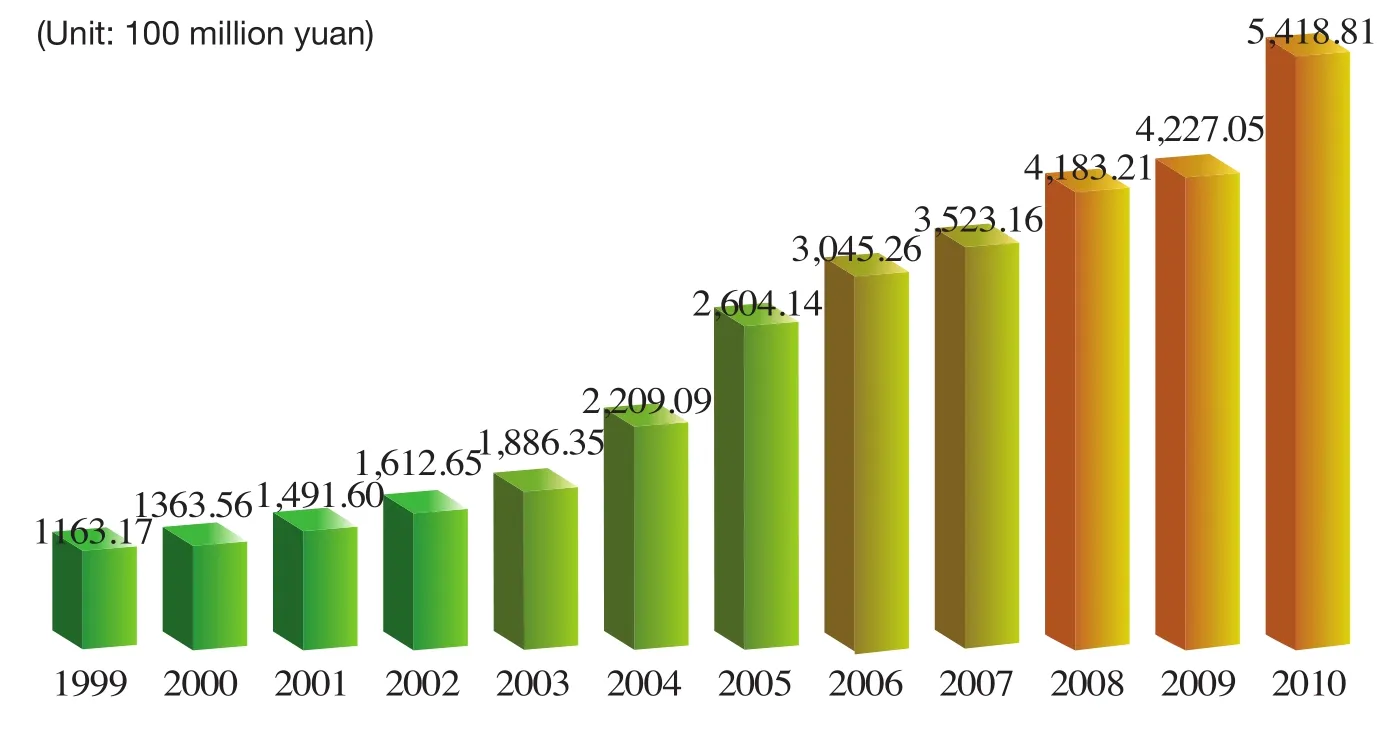
Xinjiang’s GDP (1999-2010)
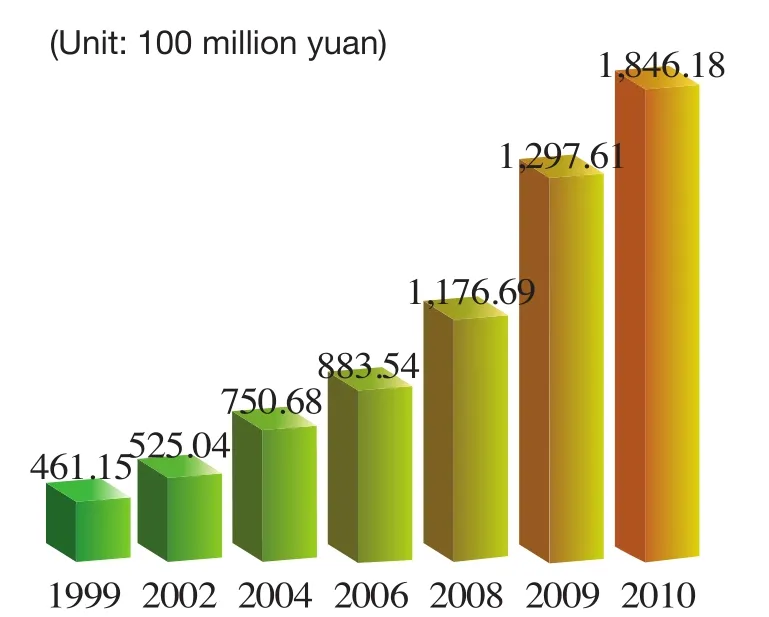
Xinjiang’s Total Output Value of Agricultural, Forest, Livestock and Fishery Industries (1999-2010)
Cross-border trade
As it borders eight countries, Xinjiang is able to boost foreign trade.
Horgos Port located on the China-Kazakhstan border is an important land crossing point between China and Eurasian states. According to Liu Jianlin, Deputy Director of the Horgos Port Management Committee, 90 percent of cargo transportation between China and Kazakhstan passes through Xinjiang by railways, highways and pipelines. In 2010 a total of 3.085 million tons of cargo worth $3 billion were transported into and out of China through Horgos Port.
China and Kazakhstan are both members of the Shanghai Cooperation Organization(SCO). Bilateral trade has developed rapidly in recent years. The trade volume between the two countries reached $20.4 billion in 2010 and is expected to hit $40 billion in 2015.
The two governments will also open a model cooperation center, which will straddle the Sino-Kazakh border. The center will serve as a free trade zone concentrating on processing trade, manufacturing,transportation, fi nancial services and tourism.
According to Liu, all four of China’s major state-owned commercial banks will have branches on the Chinese side of the center.“We expect to realize free convertibility between the Chinese currency renminbi, U.S.dollar and Kazak tenge in the center,” he said.
Liu went on to say any person and vehicle being issued a legal certi fi cate would be able to stay in the center for 30 days without a visa. The daily duty-free shopping limit for every visitor in the center will be 30,000 yuan ($4,615), making it attractive to busi-ness people. Many Chinese investors have started building factories, hotels and restaurants inside the center.

LEISURELY RHYTHM: Uygurs take a stroll in Yining City, capital of Ili Kazak Autonomous Prefecture, on July 2
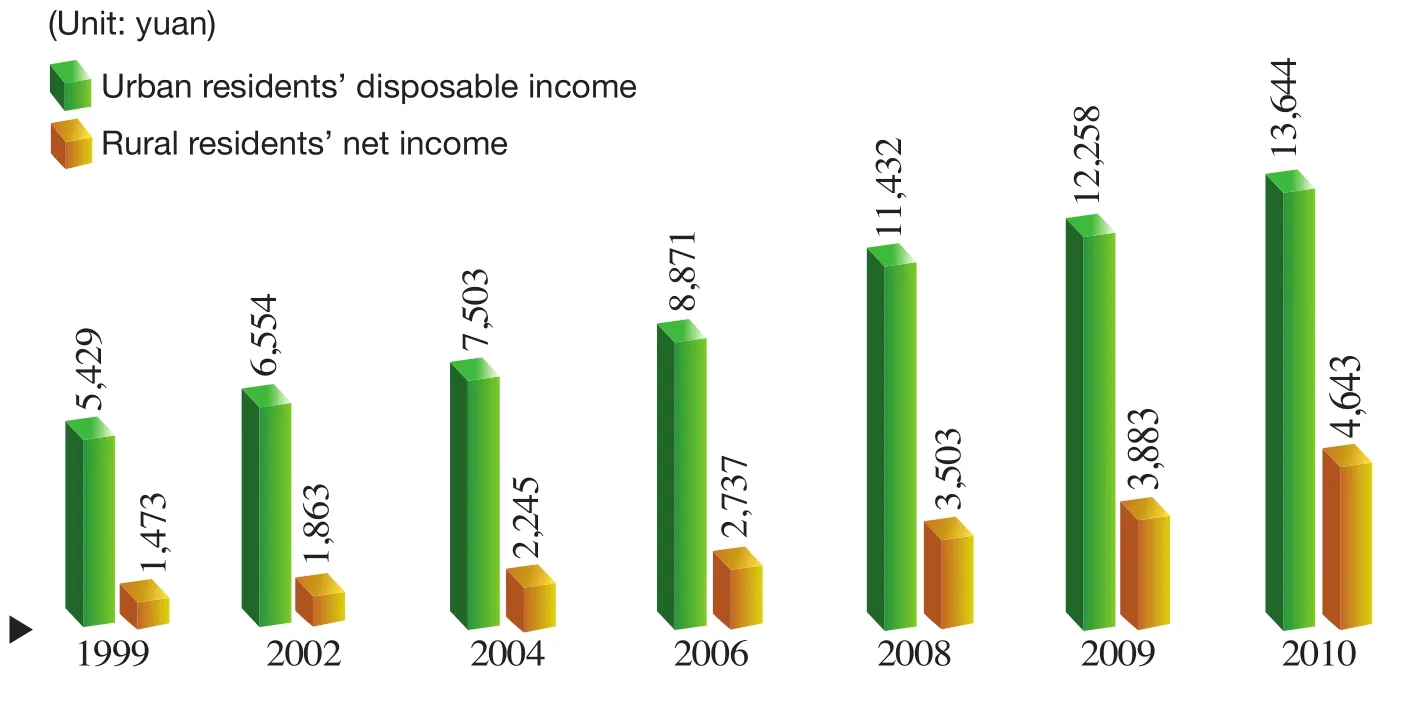
Xinjiang Residents’ Income (1999-2010)
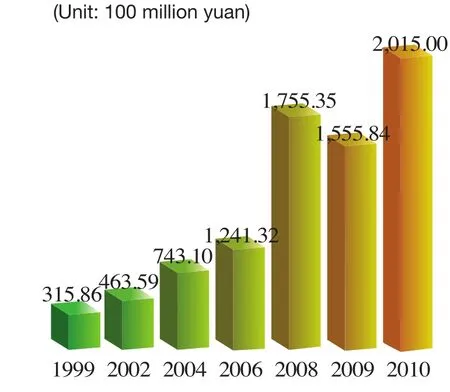
Xinjiang’s Industrial Added Value(1999-2010)
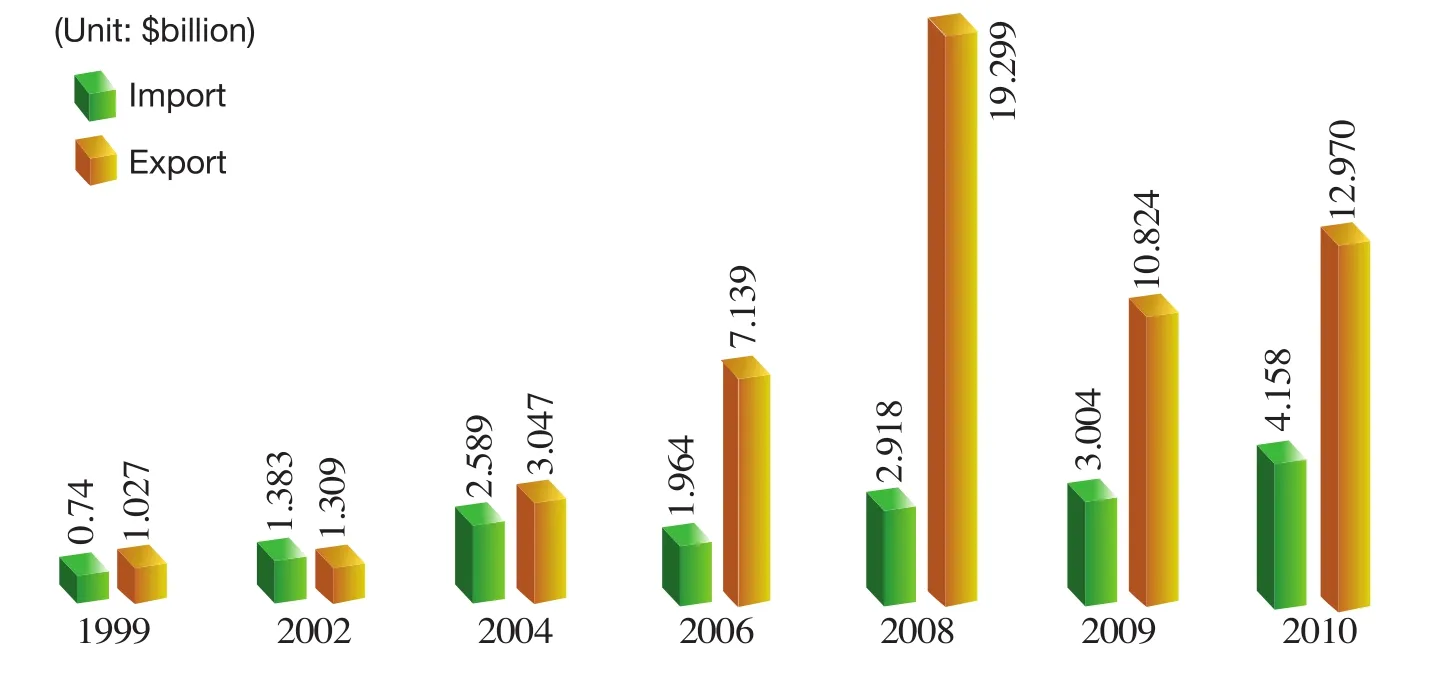
Xinjiang’s Foreign Trade Value (1999-2010)

Angel Yeast Co. Ltd. is a major yeast enterprise based in central China’s Hubei Province. Since June 2004, the company has invested 800 million yuan ($123.08 million)in Yining City, Ili. Its local branch now has an annual production capacity of 20,000 tons of yeast and its annual output value tops 560 million yuan ($86.15 million).
“Thanks to the Central Government’s western development program, enterprises investing in Yining can enjoy preferential tax treatments for up to 10 years, and our enterprise has been able to develop in Xinjiang,”said Zheng Nian, General Manager of Angel Yeast Co. Ltd.
The city’s proximity to Horgos Port allows the company to transport its products directly to central Asian countries.
Alashankou Port located on the China-Kazakhstan border in Bortala Mongol Autonomous Prefecture is accessible by railways, highways and pipelines. In 2010 the volume of cargo transportation via the Alashankou Port reached 20.74 million tons, worth $17.128 billion, an increase of 22.8 percent over 2009. Xinjiang’s fi rst comprehensive bonded zone is going to be built in the vicinity of the port.
Livelihood improvement
The Xinjiang Uygur Autonomous Regional Government has been making an enormous effort to improve living conditions of local people. In 2010, it spent 119.8 billion yuan ($18.43 billion), about 71 percent of its budget, on livelihood programs.
The regional government put livelihood improvement on the top of its 2011 agenda.According to the regional development and reform commission, in 2010 the government built 85,000 houses for low-income households and an additional 300,000 units of lowincome housing will be built between 2011 and 2015.
The regional government is encouraging nomadic households to settle in villages near their pastures. It plans to provide permanent homes, as well as schools,medical services, water supplies and electricity, for the region’s 85,600 nomadic households.
“The traditional nomadic method of moving from one pasture to another is low in cost, but much higher in risk,” said Wang Chengcai, an of fi cial in Ili.
Wang explained the herdsmen’s increasingly large herds are a threat to the ecological balance.
“Children and the elderly of nomadic households cannot receive educational and medical services,” he said.
According to Wang, after nomadic households settle down, the young and middle-aged are still able to take the animals out to better grasslands in winter while children and the elderly will be able to stay in the settlement, taking care of weaker animals.
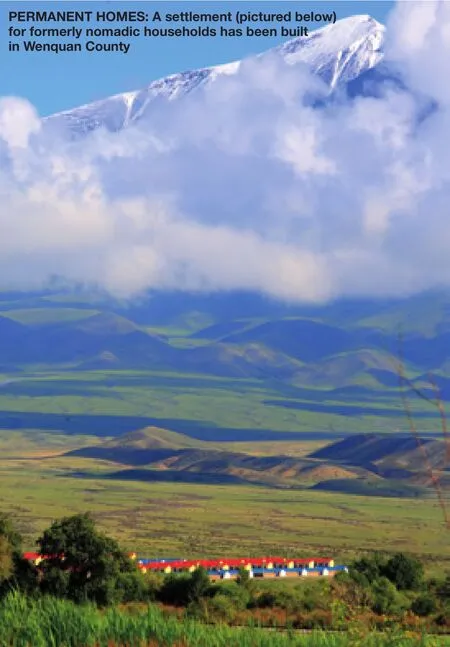
“This is a good way to combine the people’s traditional lifestyle and current needs,”Wang said.
The regional government is also working to establish a social security system, which,by 2012, will cover all urban and rural areas in the region. Subsistence allowances for low-income families and students will also be increased.
In 2010, the regional government helped 516,800 people from various ethnic groups find job while 830,000 people attended training courses organized by local authorities at all levels. The regional development and reform commission said in 2011 the government would expand the range of available training courses and create more job opportunities for welleducated young people.
The terrorist threat
Xinjiang is China’s frontline against terrorism. In July, a number of deadly attacks occurred in Xinjiang.
On July 31, three people died from a blast in Kashgar City and more than 10 pedestrians and police of fi cers were injured in an eruption of violence. The incident happened after at least seven people were killed by rioters on July 30 in the same city. Earlier,rioters attacked a police station and killed four people in Hotan on July 18.
Police investigations show the attacks were engineered by terrorist groups.
Nur Bekri, Chairman of the Xinjiang Uygur Autonomous Regional Government,said the battle against acts of terrorism will be tough and might take years to win.
“People in Xinjiang should stay vigilant and recognize terrorists and extremists are the common enemies of all ethnic groups,” said Zhang Chunxian, Secretary of the Xinjiang Regional Committee of the Communist Party of China.
Both Nur Bekri and Zhang said nothing would stop Xinjiang heading toward development and prosperity, which will be shared by the region’s people.
